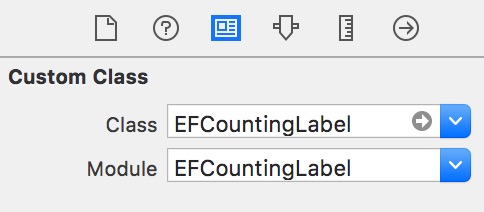A label which can show number change animated in Swift, inspired by UICountingLabel.
To run the example project, clone the repo, and run pod install from the Example directory first.
| Version | Needs |
|---|---|
| 1.x | Xcode 8.0+ Swift 3.0+ iOS 8.0+ |
| 4.x | Xcode 9.0+ Swift 4.0+ iOS 8.0+ |
| 5.x | Xcode 9.0+ Swift 5.0+ iOS 8.0+ |
EFCountingLabel is available through CocoaPods. To install it, simply add the following line to your Podfile:
pod 'EFCountingLabel'Simply initialize a EFCountingLabel the same way you set up a regular UILabel:
let myLabel = EFCountingLabel(frame: CGRect(x: 10, y: 10, width: 200, height: 40))
self.view.addSubview(myLabel)You can also add it to your xib or storyboard , just make sure you set the class and module to EFCountingLabel.
Set the format of your label. This will be filled with a single int or float (depending on how you format it) when it updates:
myLabel.format = "%d"Alternatively, you can provide a formatBlock, which permits greater control over how the text is formatted:
myLabel.formatBlock = {
(value) in
return "Score: " + (formatter.string(from: NSNumber(value: Int(value))) ?? "")
}There is also a attributedFormatBlock to use an attributed string. If the formatBlock is specified, it takes precedence over the format.
Optionally, set the mode. The default is EFLabelCountingMethod.linear, which will not change speed until it reaches the end. Other options are described below in the Methods section.
myLabel.method = .easeOutWhen you want the label to start counting, just call:
myLabel.countFrom(5, to: 100)You can also specify the duration. The default is 2.0 seconds.
myLabel.countFrom(1, to: 10, withDuration: 3.0)Additionally, there is animationDuration property which you can use to override the default animation duration.
myLabel.animationDuration = 1.0You can use common convinient methods for counting, such as:
myLabel.countFromCurrentValueTo(100)
myLabel.countFromZeroTo(100)Behind the scenes, these convinient methods use one base method, which has the following full signature:
myLabel.countFrom(
startValue: CGFloat,
to: CGFloat,
withDuration: TimeInterval
)You can get current value of your label using currentValue method (works correctly in the process of animation too):
let currentValue = myLabel.currentValue()Optionally, you can specify a completionBlock to perform an acton when the label has finished counting:
myLabel.completionBlock = {
() in
print("finish")
}When you set the format property, the label will look for the presence of integer conversion specifiers like %d, %-i, %+o, %llu, %1$ 1X, etc., and if found, will cast the value to Int before formatting the string. Otherwise, it will format it using a CGFloat, expecting a float conversion specifier like %f, %e, %g, %a, etc.
If you're using a CGFloat value, it's recommended to limit the number of digits with a format string, such as "%.1f" for one decimal place.
Because it uses the standard String(format: String, arguments: CVarArg...) method, you can also include arbitrary text in your format, such as "Points: %i".
There are currently four modes of counting.
- EFLabelCountingMethod.linear: Counts linearly from the start to the end;
- EFLabelCountingMethod.easeIn: Ease In starts out slow and speeds up counting as it gets to the end, stopping suddenly at the final value;
- EFLabelCountingMethod.easeOut: Ease Out starts out fast and slows down as it gets to the destination value;
- EFLabelCountingMethod.easeInOut: Ease In/Out starts out slow, speeds up towards the middle, and then slows down as it approaches the destination. It is a nice, smooth curve that looks great, and is the default method.
- ...
|
|
|
|
|
|
|
|
|
|
|
|
|
|
|
|
|
|
|
|
|
|
|
|
|
|
|
|
|
|
|
EyreFree, eyrefree@eyrefree.org
EFCountingLabel is available under the MIT license. See the LICENSE file for more info.










